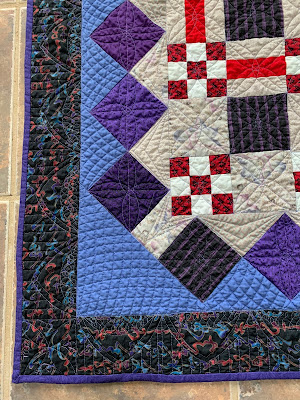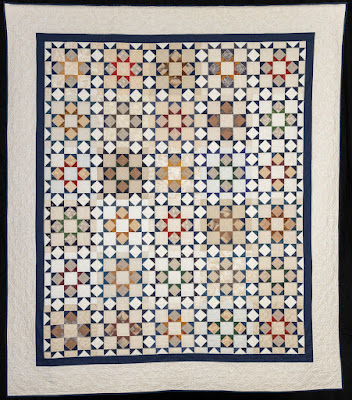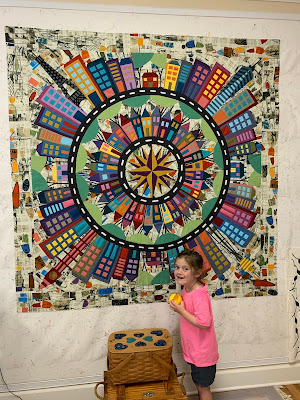Another quilt from the Special Exhibit My Joyful Journey, part of the Virtual Quilt Festival, December 3-5, 2020.
Sunday, January 31, 2021
MY JOURNEY: QUILT # 12
Wednesday, January 27, 2021
MY JOURNEY: QUILT # 11
Another quilt from the Special Exhibit My Joyful Journey, part of the Virtual Quilt Festival, December 3-5, 2020.
Monday, January 25, 2021
COLOR MY WORLD--MONTH 2
This Block of the Month quilt is available FREE to Star Members of The Quilt Show with Alex Anderson and Ricky Tims. It was designed by Wendy Williams exclusively for The Quilt Show for 2021. It is not too late to start--you will learn a lot.
NOTE: If you are a Star Member--be sure to WATCH THE VIDEO--lots of important info there too.
This month we go to the center of the quilt to make a Mariner's Compass. The pattern has excellent, step-by-step instructions with photos--take the time to read them. Wendy used two pretty blues for her Compass:
I used my two favorite kit fabrics, a shiny gold and shiny purple, for mine:Using Freezer paper for paper piecing was new to me and I found it very enjoyable. I was eager to share this process so I wrote a detailed blog about making this Mariner's Compass last June: Freezer Paper Foundation Piecing. I will touch on the most important instructions again here.
Helpful things to know and do for this month:
1. First, as always, it is absolutely essential that the 1" scale box is exactly 1". Much has been written about printing on the Forum--each person has to figure out what the correct settings are for their printer.
2. Here you can see that Section 1 and Section 2 look very much the same BUT--the darks and lights are located opposite of each other. Be sure to take the time to fold all the lines on the patterns, in both directions, just as we did in Month 1, before starting to sew:
3. It is easy to get the colors mixed up--use a pencil to write your colors on the paper to keep it all straight, especially if using more than just one light and one dark. I suggest after you cut out your fabrics, using the cutting instructions in the pattern, lay out all your pieces to be sure you have them in the proper order. It is really easy to sew the wrong piece in the wrong place--ask me how I know... NOTE: the LARGE piece, 8" x 3", is for piece F, the largest point in the Compass.
4. When piecing angles like these, it can be tricky to get the pieces lined up accurately before sewing. I use a few pins to test the placement before sewing to be sure the fabric will cover the paper completely after sewing. Pin on the sewing line, open the fabric and double-check. If it's right, sew it. If it needs to be moved just a bit, do that, re-pin and try again.
5. As pieces are added, they are pressed over, onto the freezer paper--the waxy side. The excess is trimmed 1/4" away from the line--using one of my favorite tools, the Add-A-Quarter ruler:
8. Trimming the outside curved edge is tricky with a rotary cutter. I used good quality scissors, I am a fan of Karen K Buckley's Perfect Scissors--to trim exactly 1/4" away from the dashed line, creating the seam allowance. You want the Compass points to be 1/4" away from the outside edge.
9. When joining units together that put more than 4 fabrics at one point, I always pre-check the center by machine basting, BEFORE sewing the center seam. Here are the two halves, ready to be sewn together:
13. Here is the way I pressed the back. The longest seams are pressed open--these are the seams that join the 8 wedges. Do what makes you happy:
Sunday, January 24, 2021
An OLDIE, Finished
Time for a little break from the Special Exhibit quilts for this post.
Recently, I was looking for what to quilt next, and found this small piece, made years ago, that was even basted and ready to go.
It's about 34" square. I think the pattern came from an old book by Mary Ellen Hopkins, who encouraged quilters to create their own designs, using basic traditional blocks in various layouts.
Wednesday, January 20, 2021
MY JOURNEY: QUILT # 10
Another quilt from the Special Exhibit My Joyful Journey, part of the Virtual Quilt Festival, December 3-5, 2020.
QUILT # 10: Back In Time, 70" x 70", machine pieced and hand quilted, 2001
The Story: This pattern captivated me. I used the block for a secret swap with a guild member. I first made the quilt with a very complex border. When that quilt was done I realized it is the simplicity of this setting that I loved. So I made this one. The hand quilting was a joy to do, though you hardly see it in the large plain blocks. Based on a pattern in American Patchwork & Quilting, October 2000, Living in the Past.
Let's quilt.Sunday, January 17, 2021
MY JOURNEY--QUILT # 9
Another quilt from the Special Exhibit My Joyful Journey, part of the Virtual Quilt Festival, December 3-5, 2020.
Wednesday, January 13, 2021
MY JOURNEY--QUILT # 8
Another quilt from the Special Exhibit My Joyful Journey, part of the Virtual Quilt Festival, December 3-5, 2020.
QUILT # 8: Devil's Claw, 76" x 88", machine pieced, hand quilted, 1999:
The Story: A replica of an antique quilt I bought in Virginia. I call this "planned scrappy". There is one constant fabric in each block and a specific order in how fabrics are placed in the block. The more fabrics in a quilt, the better I like it.
Sunday, January 10, 2021
My Journey--QUILT #7
Another quilt from the Special Exhibit My Joyful Journey, part of the Virtual Quilt Festival, December 3-5, 2020.
Wednesday, January 6, 2021
My Journey--QUILT #6
Another quilt from the Special Exhibit My Joyful Journey, part of the Virtual Quilt Festival, December 3-5, 2020.
Sunday, January 3, 2021
My Journey--QUILT #5
Another quilt from the Special Exhibit My Joyful Journey, part of the Virtual Quilt Festival, December 3-5, 2020.
QUILT #5 Five Easy Pieces, 86" x 93", machine pieced, hand quilted, 1995
The Story: A much simpler version of the previous quilt, Pieces of the Past--Circa 1875--based on an antique top I bought at a yard sale. This pattern is often called Wild Goose Chase. It does not have the tricky set-in four patches at sashing intersections; instead it has squares making it easy to sew together in diagonal rows. Students preferred to piece this one--no one ever tried piecing the more difficult version.
It was hand quilted by a friend who did many quilts for me in this time period. I marked and basted the quilt, she quilted it:
Let's quilt.
Barbara
Friday, January 1, 2021
COLOR MY WORLD--MONTH 1
It is finally time to start COLOR MY WORLD! I made this quilt in May and June 2020 and had to keep it quiet until November 1, 2020. Let's get started!
Here is my top finished, with the delightful Stella for scale. The quilt is about 70" square:
This month we begin to make Small Houses, 1 and 2, eight of each. In Month 3 we will make 16 more Small Houses, 3 and 4. Each of these houses is slightly different in design but the same size overall. DO NOT Sew them to each other after getting all 16 done--WAIT until Month 3 when you make 16 more that are different in design.
Here is a quick look at my Small Houses. You don't have to use the same colors I used, this just gives you an idea:
FABRIC SELECTION: You decide how to build your houses, using colors you choose.
 |
| The Kit Fabrics I received |
I recommend you cut one strip of 3.5" x width of fabric (WOF) from each fabric EXCEPT the black and white and background. The black and white are for the Inner and Outer Roads, the background is cut wider than 3.5":
Each Small House #1 and #2 are made from 4 fabrics plus the background: a door, windows, roof and the building. Use the Cutting Instructions to cut out the fabrics for your first small house #1. SAVE all the Scraps:
 |
| Small House #1 and # 2 |
Start by making one--select the 4 fabrics for the house and get started. There are videos on how to Work With Freezer Paper, and the Basics of Sewing the Blocks.
For the Background, I came up with a way to efficiently cut the background pieces with minimal waste. There is a Video for that. Find all the Videos here: Instructional Videos



































